From Social Media Ban to Total Collapse: How Nepal’s Gen Z Revolt Ended in Government Downfall
From The Wire (Sep 17, 2025)
A protest triggered by the suspension of online platforms on September 8 spiralled into deadly violence, exposing the fragility of Nepal’s political order and forcing the resignation of Prime Minister K.P. Oli.
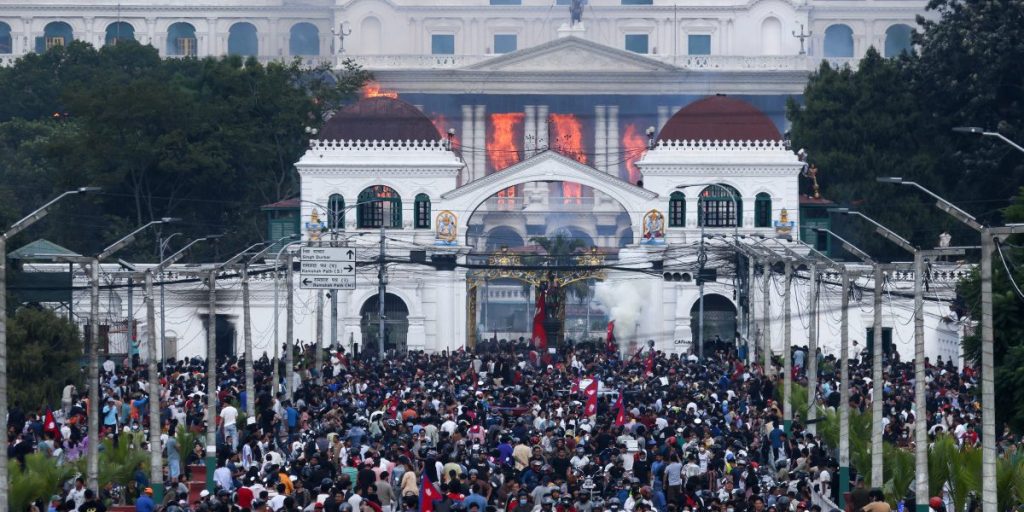
Events in the second week of September exposed how weak and mechanical the institutions of the Nepali state had become after years of political chaos and misgovernance. Beyond its other failings, the grand coalition of the Nepali Congress (NC) and the Communist Party of Nepal-UML, led by Prime Minister K.P. Oli, could not even implement a coherent plan to regulate social media platforms.
The government had issued repeated notices to international tech giants to appoint a ‘point person’ in Kathmandu, mainly to facilitate investigations into complaints and cybercrime though there may also have been the motive to control expression. TikTok and Viber complied, but others – including the US-based Facebook, Instagram, WhatsApp, Messenger, YouTube, X and LinkedIn – failed to comply with a sovereign decision issued to implement a Supreme Court order.
When the authorities announced the suspension of 26 platforms on September 4 pending registration, they failed to anticipate the fury of a populace suddenly deprived of tools on which their daily lives and livelihood depended.
The government also overlooked the dependence of more than four million Nepalis working abroad – mainly in the Gulf, Malaysia and India – whose vital link to families and news back home was abruptly severed. Meanwhile, the tech giants, despite maintaining offices across much of the Global South, continued to snub Nepal.
The resulting public frustration was captured by youngsters who organised a protest in mid-Kathmandu on September 8. What till then was a loosely formed group of the ‘Generation Z’ youths calling for the revocation of the suspension of social media platforms, became larger with pertinent demands like good governance and transparency.
Importantly, they called out corruption in high places, uncontrolled despite successive media exposés over the years.
These investigations conducted by diligent mainstream journalists exposed land grabs, cooperative scams, gold smuggling, government appointments, human trafficking and a dastardly plan to make money off fake refugee registrations.
These widely publicised exposés found little traction in the courts and state administration and led to brewing resentment among the mass public, including the IT savvy youth. Lending fuel to the bitterness was the conspicuous consumption of the scions of some of the topmost leaders, including Maoist chief Pushpa Kamal Dahal (‘Prachanda’), Nepali Congress leader Sher Bahadur Deuba and others.
The coalition government’s overall failure of governance also fed public anger. Prime Minister Oli was not quite the autocrat portrayed in populist rhetoric, though he came to embody a corrupt and dysfunctional system. His tenure was marked by accommodation to Nepali realities: an opportunistic Maoist leader waiting in the wings, the unsettled state of fledgling federalism, constant meddling from New Delhi and a weak, demoralised bureaucracy.
Despite his record of steering the polity past many political and geopolitical shoals in the past, Oli had grown increasingly remote from political counsel and prone to mistakes within his party and in government. Having bounced back into politics with double kidney transplants, his many Machiavellian victories may have made him feel invincible.
Dismissive of the Kathmandu intelligentsia, Oli ultimately evolved as a target of public derision.
Meanwhile, the coalition government failed to initiate the constitutional reforms that Oli and Deuba had pledged as the basis of their grand alliance. And for an astute politician who prided himself on being an expert in feeling the public’s pulse, Oli appeared feckless in the face of algorithm-driven populism.
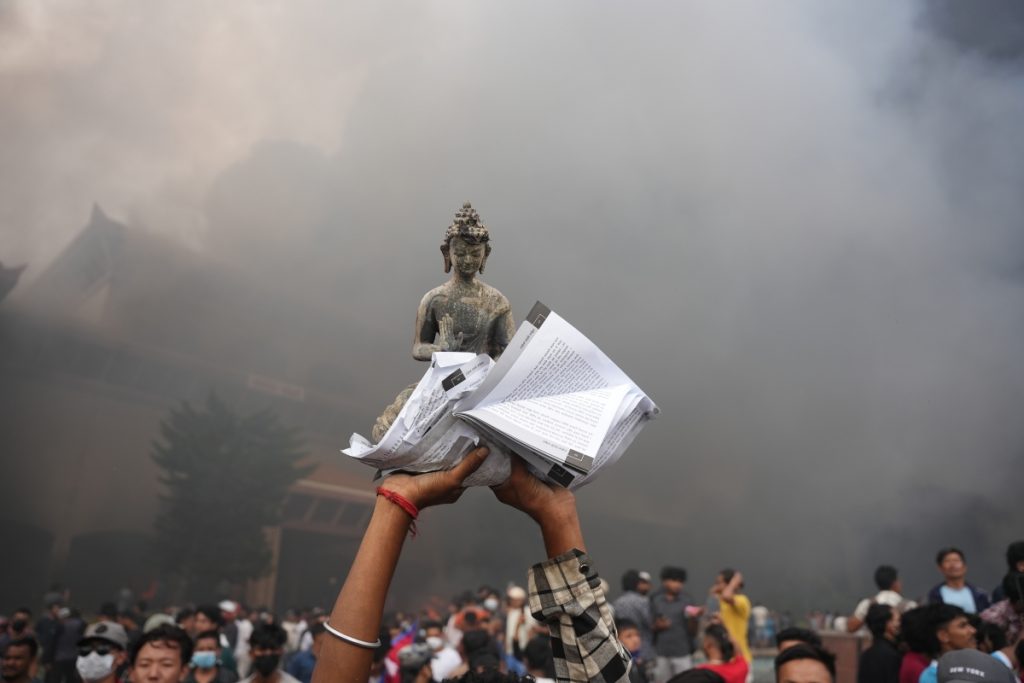
September 8
A turning point for the polity of modern-day Nepal thus arrived on September 8, as school children in uniform and college students gathered at the Maitighar Mandal roundabout in downtown Kathmandu, beside the Supreme Court.
Initially, the Gen Z protest proceeded smoothly and confined itself to the area assigned by the civil administration, but soon things began to go awry – what in retrospect appears to have been a pre-planned effort by actors who hijacked the rally from the youths, misusing the platform.
The demonstration lasted three hours, from 9 am till noon on Monday. Around then, a notice went out on the internet from a Gen Z account warning of infiltration: “Please exit safely and ASAP. There are too many vested groups rattling the mass. We successfully won the day. Let’s get home today safely.”
However, before that could happen, a section had moved towards the parliament building.
The police force failed in its duty. It did not apply the accepted measures of riot control – the sequencing of barricades, batons, teargas, water cannons and rubber bullets – and allowed the crowd to break through into the parliament premises, at which point the Special Task Force (STF) is said to have started aggressively firing live bullets.
The quantum of force was tragically out of proportion with the danger posed by the demonstrators. By evening, at least 19 young citizens were dead, and more than 300 wounded filled the hospitals.
As of now, the tragic tally stands at over 70 deaths and more than a thousand wounded.
As the next morning unfolded, it hardly seemed like a determined conspiracy to commandeer the youth demonstration; perhaps the quiet and determined rally had simply been taken over by the kind of anarchists found in every society, exploiting a power vacuum. But the violence that erupted later that day and the next pointed to a deliberate and long-planned attempt to overturn the constitutional order and parliamentary democracy.
Those who flooded the streets and stormed institutions likely included common criminals, party cadres, former Maoist guerrillas, renegade Gen Z members and monarchist-anarchists acting under internal and external influence.
The deaths at the hands of the police immediately created the conditions for the downfall of the NC-UML government. Politically, those who stood to benefit from the crippling of the two parties that had dominated the polity since 1990 included Balen Shah, the ambitious mayor of Kathmandu city, who keeps aloof from the press and relies on a tight and efficient circle of social media managers.
There is also the Rastriya Swatantra Party (RSP) of populist journalist-turned-politician Rabi Lamichhane, which would like to expand parliamentary strength through early elections, otherwise scheduled for November 2027.
Waiting in the wings are some independent neophyte politicians, as well as technocrats who have achieved populist fame, and who could step up amidst the unraveling of state institutions.
As far as the Maoist party is concerned, which has been progressively weakened electorally, any breakdown of the state howsoever achieved, was welcome in order to take advantage of the situation.
Then there is the royalist Rastriya Prajatantra Party (RPP), which has functioned under the constitutional regime but seeks a return of kingship by dissolving the federal, secular, republican state structure.
Even with ‘constitutional monarchy’ in name, their revival would create such a powerful kingship that democracy and pluralism would be dead for all practical purposes.
Beyond the RPP, there are also radical monarchists and the Hindutva brigade backed by India’s RSS, which has opened an office in Kathmandu and ramped up its activities in Nepal’s hills and plains over the past half-decade. Their effort would be to exploit the bedlam to foist a ‘Hindu state’ through the restoration of the monarchy, given that the efforts of the deposed king, Gyanendra, had proved a non-starter in March 2025.
Oli’s departure
At the beginning of September, Oli would have thought he was in total command of both, his party – CPN (UML) – and the larger polity. He returned from a China visit, after attending the Shanghai Cooperation Organisation summit in Tianjin and the September 3 tamasha of the Victory Day Parade in Beijing.
The prime minister had been energised by his meetings with Xi Jinping, Vladimir Putin and others, and in the formal bilateral meeting, he even found an opportunity to question President Xi for having recently made a deal on cross-border trade with India through Lipulek Pass, which Nepal considers its territory.
On September 7, at a UML meet, Oli had pushed through changes to the party constitution – allowing him to run for a third term as chairman and past the age of 70 – both restrictions he had earlier insisted on. Later in the month, the prime minister was set to visit Bodh Gaya in Bihar for a long-expected meeting with Indian Prime Minister Narendra Modi.
Such was the height from which the prime minister was made to descend, resigning only two days later. Amidst all this, one must certainly ponder the geopolitical interests that may have been at play directly or indirectly in subsequent events.
There is Washington DC’s wariness of Beijing’s growing influence in Asia and worldwide, while the New Delhi establishment has been hostile towards Oli as the one who pushed through the revised Lipulek map through constitutional amendment, and stood firm amidst the Indian Blockade of 2015.
Oli had thought that Meta and other companies would ultimately concede to the government’s demand to open offices in Kathmandu, as a couple of others had done. He and the minister of information and communication, Prithvi Subba Gurung, did not expect the reaction of a populace that, besides using the social media platforms for communication, information and commercial needs, was by now addicted to the apps and smarted under the suspension.
Oli also miscalculated the timing of his resignation. Had he let go on the evening of September 8, the party machinery of the NC and UML could have come up with a new, younger, government leadership through parliament. The delay contributed to the power vacuum of the next day, delivering mayhem amidst the military’s inaction.
Given the unexplained absence of President Ramchandra Paudel, who should have set the narrative and assumed command under the Constitution, the central role in managing the rapid transition fell to the Nepal Army and its chief, General Ashok Raj Sigdel.
September 9
The arson and attacks of September 9 were nationwide and devastating, bringing the country to a dead halt, from roads and air services to tourism, and all aspects of governance and public life. The Supreme Court, Singha Durbar government secretariat and parliament were all torched.
The secretariat, built in 1908 and including the impressive baroque Gaddi Baithak hall, had been painstakingly restored over 10 years following the April 2015 earthquake.
The mob set fire to the president’s office of Shital Niwas, also restored post-earthquake. A complete listing of the arson and vandalism of public and private property will take more than a year to complete.
The papers of the Court, the secretariat and parliament went up in smoke, as did the holdings of land administration, internal revenue and customs offices. The loss of papers and records will make it that much harder to get the government and economy back and running. There was no authority in place throughout the horrific day, nor were communities able to challenge the mobs as they attacked structure after structure, home after home, working off a prepared checklist, using geolocation apps, walkie talkies and incendiary devices.
The Nepal Police and Armed Police Force were absent throughout, themselves besieged by the disruptors and their guns looted, while fire-fighters were blocked from doing even the little they could have. The great edifices of the government secretariat, judiciary and legislature, enduring symbols of the Nepali nation-state, were allowed to burn into the night with onlookers only taking selfies.
One nighttime drone footage over the Valley stood as mute witness, while on the ground the acrid smell of burnt wood, paper and plastic filled the air. For two days, even the monsoon refused to come to the rescue, leaving fires and embers to burn themselves out.
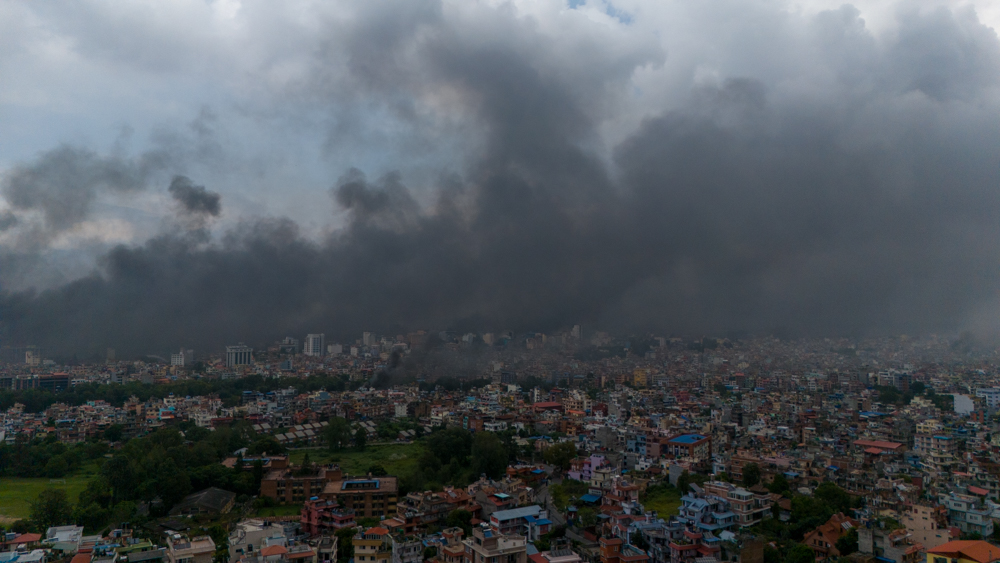
Party offices, newsrooms, schools, hotels, malls, cable cars, police posts, and auto showrooms were targeted. The Bhat-Bhateni supermarket is a successful chain with 27 multi-storied establishments around the country; only seven are left standing. Even as many residences, big and small, official and private, linked to politicians, businessmen and public personalities were razed, it is significant that the former royal palace of Narayanhiti, and the Nirmal Niwas residence of ex-king Gyanendra were left untouched.
While the Nepal Army generals would have known that the September 8 killings would deliver an eruption of violence the next day, they seemed unprepared or unconcerned. The Army took all of September 9 before it woke up to the need to patrol the streets, coming out only at 10 PM that day, by which time, the agitators had completed their task at leisure.
The military headquarters at Bhadrakali stands on a low hill overlooking the parliament, Supreme Court and Singha Durbar, all of them within a radius of two kilometres. There is a battalion stationed within the Singha Durbar premises, which should have protected all three institutions. The soldiers did not move – it may have been intentional or incompetence – while the public wept.
By way of defence, Army officers have told members of the political class that the COAS met the likes of the royalist Durga Prasai and Gen Z representatives in order to shield them from the President, who is officially the Nepal Army’s supreme commander-in-chief (Paramaadhipati).
As for the inability of the soldiers to control the arson and looting, they point to the protocols that govern the military’s deployment, which is also what they did during the initial years of the Maoist insurgency when they stayed in the barracks. Further, they maintain that had the soldiers actually acted against the crowds, there would have been uncountable deaths.
The word is that over at his official Baluwatar residence, PM Oli was committed to sitting out the crisis, but decided abruptly to step down when he was informed by the army that he no longer had its support. The veracity of this information will have to be investigated and understood in the days to come.
Amidst the melee, the need for a proper and public transfer of power was neglected. The mobs were emboldened in the ensuing absence of authority.
Sher Bahadur Deuba and his spouse and foreign minister Arzu Deuba (till the prime minister’s resignation), were badly beaten in their residence and dragged out by enraged rioters, who gleefully shared heart-rending videos. Injured, they were finally rescued by security personnel.
Other ministers and officials were humiliated in public while they lost their properties.
As an observer said, “By the end of the day, the government was broken and the leaders homeless.”
Even at the time of writing this article, with an interim government announced, the public does not know the whereabouts of the ex-prime minister and several other ministers.
Did a matter of providing personal security evolve into undeclared house arrest, as was also the case with the chief ministers of all seven provinces?
RSP leader Ravi Lamichhane, being investigated for fraud in cooperative companies, was spirited out of Nakkhu Jail by invading supporters who led to the ‘liberation’ of all the inmates. According to police statistics, 14,507 prisoners escaped from prisons all over the country, triggered by the Lamichhane episode, and only 455 have been brought back in.
Among the thousands who fled was the mastermind of a 2012 bomb blast in Janakpur, which killed five Maithili activists, an Indian national serving time for kidnapping and ransom and a Maoist former minister is being investigated in the fake refugee scam.
Convicted murderers, rapists and all kinds of felons are walking freely on Nepal’s bylanes and communities, some of them bearing looted arms. With the mass exit of prisoners, Nepal’s society has been made insecure from an unexpected source.
If the interim government is unable to immediately manage law and order through the police force, communities from all over the country will start taking charge of their own security, which will have its own dangers of vigilantism.
Amid the smoke and ruins, the survival of Nepal’s constitution itself is suddenly in question.
Kanak Mani Dixit is a writer and Founding Editor of Himal Southasian magazine as well as a civil rights activist based in Kathmandu Valley. kanakmanidixit.com
This is the first part of a two-part series on the Nepal interregnum.
After the Inferno: Nepal’s Gen Z, the Army and the Battle for Constitutional Survival
From The Wire (Sep 19, 2025)
With institutions torched, an unlikely interim government led by former Chief Justice Sushila Karki has emerged – leaving Nepal’s democracy wounded but not broken
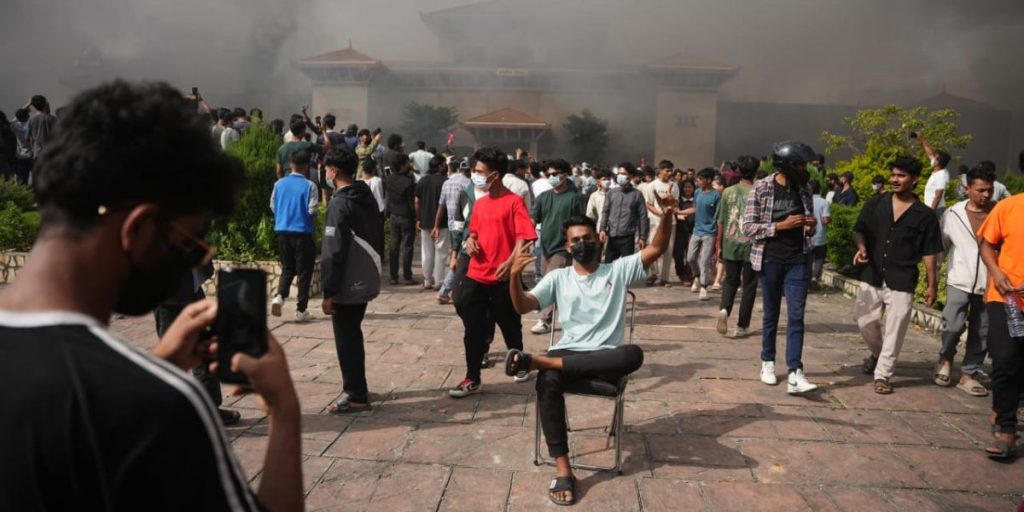
Amidst a fluid situation in Nepal, with the Nepali Congress (NC) and NCP-United Marxist Leninist (UML) of the ruling combine on the back foot – the killings of September 8 having occurred under their watch – It took a few days for their cadres to regroup. But with the main leaders incommunicado, it was too late for them to try and stop the disbandment of the lower house and the formation of an interim government as negotiated between the president, the Army and a determined ‘Gen Z’ flank.
There is the suggestion that, by themselves, the Gen Z groups would have been able to muster less than the huge mass that gathered on the ground on September 8. Ex-king Gyanendra Shah’s anointed representative of sorts was the provocateur entrepreneur Durga Prasai, who tried desperately to make common cause with Gen Z and the Army chief Ashok Raj Sigdel, though unsuccessfully.
Over two days, the mainstream political cadre were forced underground amidst targeted threat to life and limb, and hence unable to influence the rapidly evolving dynamic among the Gen Z supporters who efficiently used group chat apps, including Discord, to mobilise.
The disparate Gen Z groups seemed to coalesce around a non-profit called Hami Nepal, led by Sudan Gurung (36), who had earlier described himself as merely a facilitator of the youngsters’ rally of September 8. The main individuals who gave the call for the rally had somehow been pushed into the background, which is another story that has yet to be written.
Unlike the royalists who hoped for the very collapse of the 2015 constitution, the Gen Z and their non-establishment forces abandoned the initial desire for constitution dissolution but stood firm on disbanding the lower house of parliament, including on the advice of Mayor Balen Shah, to disallow the mainstream parties a pulpit.
They agreed on the need for an interim government which would organise elections within six months on a fixed date, as required by the constitution. The longer term goal of the politically-minded would be to generate a two-thirds majority to dismantle the secular, federal and republican frame, and a large number would want a directly-elected national executive.
This is also the position of Mayor Shah of Kathmandu, who has proved influential among the Gen Z groups. While the new forces now hope to take advantage of the unpopularity of the two large parties, the announcement of March 5, 2026, as the election date also allows sufficient time for the older parties to regroup.
As far as elections are concerned, the September 8 killings have certainly tarred the UML and NC, which held the prime ministerial and home ministry portfolios, respectively. Neither ex-Prime Minister K.P. Sharma Oli, nor former home minister Ramesh Lekhak can evade accountability to the extent of holding those positions.
For its part, the RSP will have to try and explain the legality of Rabi Lamichhane’s extraction from Nakkhu Jail and own some of the responsibility for the escapees countrywide, that has left communities everywhere unprotected. The Gen Z groups cannot evade responsibility in sharing their perspective as to what went wrong on September 8 after their demonstration was over, and whether some of their own did aid and abet the infiltrators and participate in the destruction of the day after.
As the dust settles, questions will also be asked about the sagacity of asking school-going minors to attend a public demonstration.
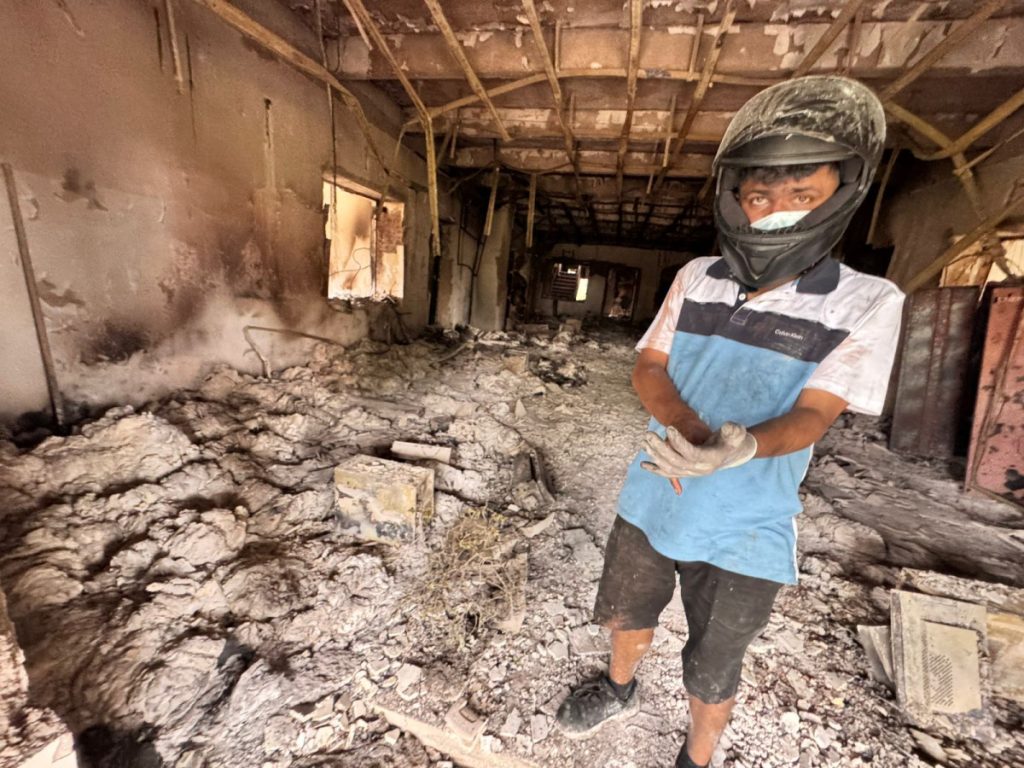
President Paudel
Incredibly, amidst the week of distress and debate following September 8, President Ramchandra Paudel was nowhere to be seen, offering neither authority nor reassurance to the nation. He did not address the nation, and bypassed in the initial negotiations with Gen Z representatives which happened in the Army’s Bhadrakali Headquarters.
It is likely that he was kept under tight security by the military, initially for protection amidst the rioting, but later perhaps to allow time for the generals to manoeuvre with regard to the final denouement. Regardless, on September 14, the president came out with a carefully crafted signed statement which, read between the lines, indicates the he had to use all his guile to work between the army and the clamouring youth representatives to save the constitution and parliamentary democracy.
In his brief statement, President Paudel stated:
“With great effort, a peaceful release has been achieved for the country from an extremely agonising, unexpected and dangerous situation. The constitution has been saved, parliamentary democracy has been saved, and the federal democratic republic is maintained. The people now have the opportunity to proceed towards an even more advanced democracy through elections to the House of Representatives within six months. I request all sides working on behalf of the people to show self-restraint and contribute to the holding of the 5 March elections, making use of an opportunity which has been achieved through great skill.”
While the President was working things out with the generals and the Gen Z representatives, thousands of youth on group chat apps were debating who was to be their choice as prime minister. At first, they chose ex-chief justice Sushila Karki (73) as their interlocutor, and she rapidly became the prime ministerial candidate of Gen Z – an indicator that they were focused on experience rather than be fixated on age.
Known to be headstrong and uncorrupt as a judge, she was certainly a better option than a raft of pretenders. While her blunt talk has often been off-putting for the mainstream political leaders, whom she distrusts, she has ethical boundaries and a commitment to civil rights that have not been questioned. As such, it is hoped that she will be able to talk back as required, both to the Army, unrestrained followers and colleagues, as well as to foreign interlocutors.
Interim PM Karki
The large mainstream parties began showing their presence on September 10, when UML leaders Pradip Gyawali and Shanker Poudel spoke up, as did the party’s secretariat. The co-general secretaries of the NC, Bishwa Prakash Sharma and Gagan Thapa stated in a joint statement that same day:
“The President must hold discussions with all parties while seeking to solve the present crisis. We should not go out of the constitutional track, and any new political structure cannot be created outside due process.”
Amidst the curfew and fearful atmosphere, they also broadcast powerful video messages.
By September 12, proving that Nepal’s civil society was not dead, as suggested by many, there was a flood of statements and positions from diverse sectors, human rights groups, intellectuals of all colours, the Bar, the indigenous rights groups and others around the country speaking up for the constitution. They asked President Paudel to stand by the document rather than be pressured by the urgings of Gen Z representatives for immediate interim government formation.
Word emerged late on September 11 that the president was meeting with constitutional lawyers in the presence of Army Chief Sigdel, which transmitted a sudden message of calm to the intelligentsia.
At least some of the constitutionalists came away from that meeting reassured that the president himself would chair the transitional government, making someone like Karki vice-chair and chief executive of the government, and to announce elections which would ipso facto have dissolved the House of Representatives. Their suggestion was not to go the Bangladesh way of last August when the PM Sheikh Hasina’s departure from Dhaka, dissolved the parliament through explicit announcement following the Bangladeshi president’s discussions with the heads of the three military wings, student leaders and others.
However, President Paudel was evidently unable to withstand the pressures from the Army and the Gen Z groups. While the Army officers apparently warned that an emergency would have to be declared if he did not act on appointing Sushila Karki, Gen Z representatives went into an instantaneous social media campaign for the dissolution of the lower house, intent on establishing facts on the ground. It did not take President Paudel more than a day to go along.
Nepal had experimented with a non-parliamentarian head of government back in 2013, when the sitting Chief Justice, Khil Raj Regmi, was made prime minister to oversee elections. That was when a provision existed for such a departure from the 2007 interim constitution, whereas no such provision exists in the 2015 document. To find a convoluted way out, President Ramchandra Paudel announced that, in consultation with Prime Minister Oli in hiding (and his resignation letter in absentia), and the general powers vested in him to protect the constitution, he was appointing Karki as interim prime minister.
As per the agreement with the president, Army and Gen Z representatives, interim PM Karki immediately announced the dissolution of the lower house and set the date for elections as March 5, 2026.
Immersion course
As far as the Gen Z entities who called the initial demonstration are concerned, their demands for transparency, good governance and non-corrupt leadership, was of course, on target. This had long been a concern of civil society generally, one that had been ignored by the political class and successive governments. While many of the participants at the rally were school and college students, more information will, doubtless, emerge in the days ahead about the background and agenda of the organising groups and their promoters. Their ability to change the course of the evolution of the Nepali polity requires embracing their achievements, even if information is sought on their origins and goals.
There is credible information that, by themselves, the Gen Z groups would have been able to muster about two or three thousand people on the ground on September 8. Whether it was by invitation or otherwise, to swell the numbers, ‘reinforcements’ seem to have arrived from the RPP, RSP and Maoist parties, as well as Durga Prasai’s contingent, to make up more than 12,000. That, in fact, may help explain the unplanned march on parliament, which turned so deadly, as it was not part of the announced Gen Z agenda.
Sadly, the ultimate sacrifice of so many young activists killed in police firing was driven largely out of focus amidst the violence of the following day and the pitched political contestation that followed, and is bound to continue.
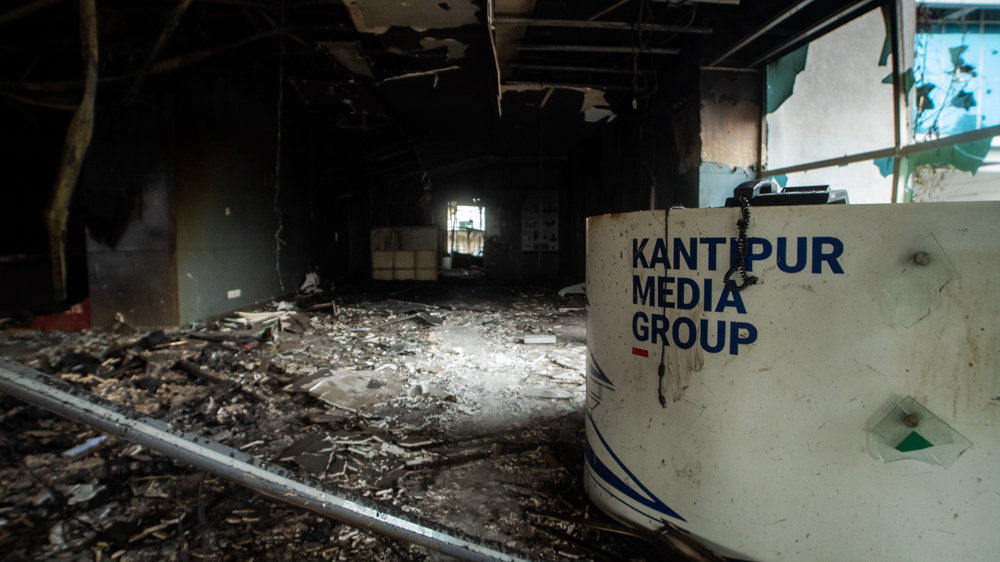
A study of the social media handles of groups professing Gen Z identity shows that several started taking the name ‘Gen Z’ after September 7. At least one large and prominent Facebook group’s past names indicate commitment to political Hindutva. However, it was the Hami Nepal (‘We Nepal’) group which surged to the forefront after September 8, having been started (as evident from its website, which is in English) in 2015 to support earthquake victims, followed by activism during the Covid-19 pandemic.
The leader of Hami Nepal, Sudan Gurung, emerged as the key player in openly shared chat group discussions and the voting that led to the ultimate ‘voting’ that proposed Sushila Karki as the Gen Z’s choice for interim prime minister. The fact that Mayor Balen Shah had put his weight behind Karki may have swung the youth vote in her favour. The centrality of Hami Nepal was also evident in the pride of place given to Gurung and his group in the swearing-in ceremony of September 12 evening.
Sadly, the event had none of the gravitas of a national occasion and, as seen on television, it trailed off like a loose gathering of friends in an NGO gathering. Incidentally, none of the political parties were represented at the ceremony other than the Maoist without-a-following, Baburam Bhattarai.
The Gen Z activists are certainly tech-savvy, and are able to use digital tools to grab and spread information near and far. One does not know if many of the activists have commitments beyond the professed grievances that led them to organise the three-hour dharna of September 8, what principles or ideologies they hold dear, or their understanding of history, geography, politics and geopolitics in a society where these subjects are not really taught in schools or colleges anymore.
One could say, however, that the events of the past week would have provided the bloggers, podcasters, content-creators, influencers, as well as lay members of the Gen Z category an opportunity to seek out political context and comparative experiences. In short, as members of a generation that was said to profess disdain for party politics, they are being positively politicised through this ongoing ‘immersion course’ on state and society, despite the extreme physical and emotional toll.
Further, learning from the ‘colour revolutions’ of Eastern Europe, as well as recent movements in Sri Lanka, Bangladesh and Indonesia, one hopes that Nepal’s Gen Z activists are alert to the neoliberal and fundamentalist polarisations that could emerge. If it is true, as seems to be the case, that the Gen Z call to the streets of September 8 was hijacked by anarchists that had been lying in wait for such an occasion, the youth activists must express themselves, as also they must on the countrywide violence of the day after.
Further, if the known and unknown forces decide to sabotage the March elections and lead the country towards fundamentalism or authoritarianism, it will be the Gen Z youth who would have to join other democratic demographics to save the day.
Voices for inclusion
To their credit, with the Gen Z representatives having agreed on the interim prime minister under the constitution, the dangers to constitutionalism seem overcome for now, even without the lower house. The hopes of the Maoist leadership that it might be able to fish in troubled waters have been dashed. The Army is more or less back in the barracks. The ex-king has failed to make away with someone else’s movement. Whatever changes are to be made in the constitution will now happen following the elections, based on the showing of different parties and ideologies.
While the term ‘Gen Z’ represents an entire generation born between 1997 and 2013 of the Gregorian calendar, one may question which part of Nepal’s demography is represented by those who sat on the three-hour demonstration, and whose leaders suddenly found themselves in a position to negotiate with the President and the Army as to the head of government.
Amidst the rush of events, it is important to know whether the diversity of historically marginalised communities and voices of mountain, hill and plain that contributed to the writing of the 2015 constitution are fully represented within the demographic of the September 8 demonstrators.
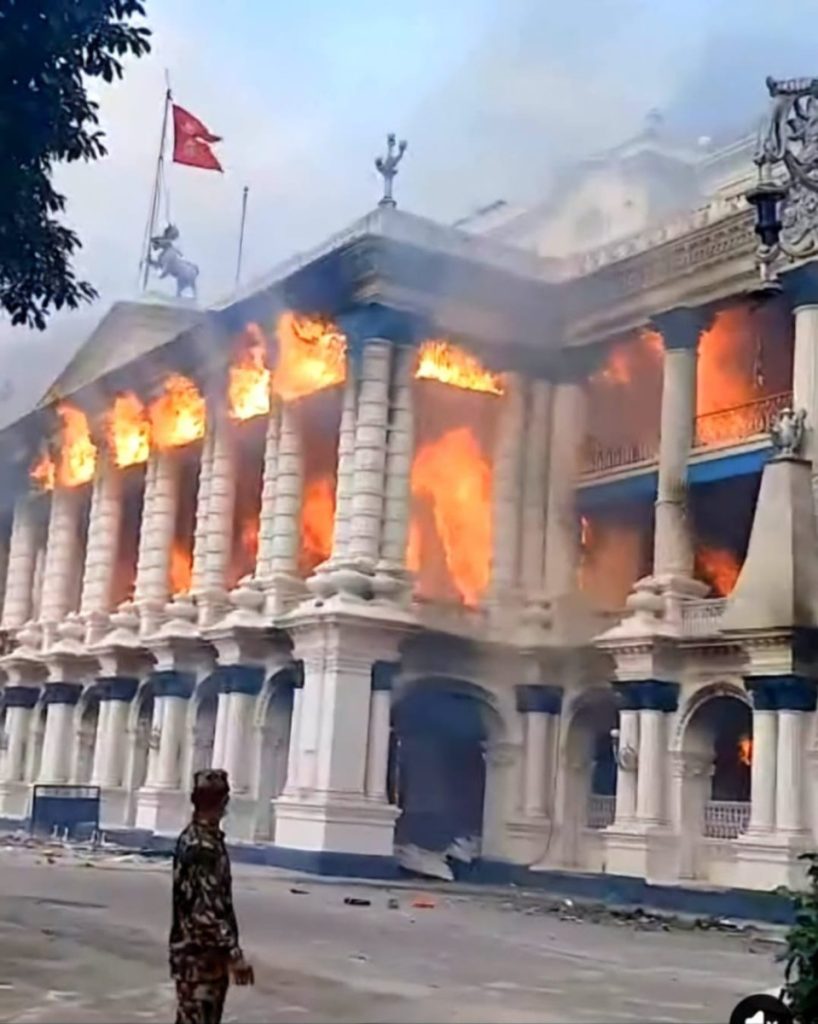
Does the language of the very articulate Gen Z activists include to ‘civil and political rights’ and ‘social justice’? Are the political freedoms that are the legacy of the 1990 constitution, and ‘inclusion’ which is the contribution of the 2015 constitution, in their radarscope?
While individually there would be diverse representation in the Gen Z rallies, going forward and beyond generalities, the activists will doubtless keep in mind the need to understand the hopes and expectations of the Dalit, Janajati, Muslim, Madhesi and others, as well as the disabled, including the ‘Generation Z’ within these categories. Nor should they forget the senior citizens, a large and growing group which should never be forgotten amidst all the talk of ‘youth’.
The concerns of losing hard-fought gains are what made the Federation of Democratic Indigenous Nationalities come out on September 12, warning against attempts to derail the constitution and its provisions.
The investigations into the violence of the past week by the government of interim Prime Minister Karki must start with why the police shot point-blank at protestors on September 8, and why the Nepal Army did not move to stop the mayhem on September 9. The new government may also consider reverting to the previous government’s communications to the international social media platforms, and ask the ancillaries of Meta, as well as X, LinkedIn and others, to register contact points in Nepal.
Build back better
Right now, with the help of the army and its declared curfews, Nepal has achieved a level of calm. The power vacuum has been filled with the announcement of an interim government within the constitution, including the induction of three ministers.
Modern Nepal is a society that has suffered 30 years of royal autocracy, a decade of brutal insurgency and the scorched earth response of the state, and been visited by every-decade-or-so calamities, including a massacre inside the royal palace, a major earthquake, a blockade, cloudbursts and floods. The events of September 8-9 should not in any way provide an excuse for rule by authoritarians or religious extremists. Nor should the interim government think that it can start prejudicial activities to prevent the NC and UML from their political activities, but such actions are bound to spiral out of control.
Any such attempt would simply mean that a battle for Nepal’s soul would start all over again because 35 years of freedom means that such a pushback towards a closed society would ultimately fail. However, much time would be lost, which is why it is significant that the 2015 constitution is extant and the document needs national and international protection.
Beyond the elections of spring 2026, the fight for social justice requires a continuation of the parliamentary democracy introduced by the 1990 constitution and retained in the 2015 constitution, though the latter can and must be amended through democratic negotiation.
The talk of the directly-elected chief executive, which has been bandied about over the past week, was actually the plank of the Maoists when they thought they would convert such a position to long-term state capture. In reality, abandonment of the parliamentary system and placement of a directly elected president or prime minister would not be able to represent Nepal’s diverse population and regions.
It would also make the polity even more vulnerable than it is today to external influence and manipulation. Further, while the 2015 constitution does require revision in numerous areas, as far as the federal provincial structure is concerned, the goal should be to improve its functioning based on the experience of the past decade rather than throw the baby out with the bathwater.
Even though the lower house of parliament has been disbanded under the doctrine of necessity, the speaker is still in his position under constitutional provisions. The upper house remains in place, as is also the case with the seven provincial governments and 753 local governments with their elected leaders and ward officials. It is worth considering that the nefarious plans of the known and unknown agent provocateurs also failed because these representative institutions remain as the foundation.
Parliamentary democracy has only been partially wounded in the search for a practical solution under the doctrine of necessity applied by President Ram Chandra Paudel.
While the constitution does not have provisions to limit the powers of an interim prime minister, the government she leads should clearly concern itself mainly with restoring law and order, organising the March general elections, reconstruction of state and society, and investigations into the violence of September 8-9.
The regular functions of state administrations should continue with more diligence than shown by earlier governments, including the revival of the economy and pursuing cases of corruption. Any untoward adventure by the interim government, emanating from any quarter near and far, would be thwarted by the institutions that do exist, in particular, the Supreme Court. For that reason, there is a need to be alert to actions that may undermine the Supreme Court as the institution of last resort.
The NC and UML parties can be expected, for their own survival if nothing else, to defend due process. However, both parties must emerge from the bossism which has defined their functioning of the last few decades. They must extricate themselves from foreign influence and also rebuild their internal democracy, in the process also devolving authority and agency to the provinces and local governments to reflect the federal structure.
The 2025 Gen Z uprising was not the first time Nepal’s youth rose up against the prevailing regime. In April 1979, student-led agitation against the hanging of former prime minister Zulfikar Ali Bhutto in Rawalpindi had forced the royal regime of King Birendra to concede and announce a plebiscite to choose between the ‘reformed’ panchayat system and multiparty democracy.
As someone who fought the royal panchayat regime when it was at its more autocratic, interim Prime Minister Karki is obviously alert to the dangers of non-party (nirdaliya) government; she must therefore strive to form a representative cabinet. Any coercive departure is bound to spontaneously bring the civil society and the people en masse onto the street to protect what has been achieved over three decades, and to prevent a regression to the times of old. Political adventurism would not be a good idea – neither for the government, the Army, nor for political entities old and new.
Nepal should gird up to rebuild anew on the basis of the constitution, with a guarantee of the March 5, 2026, date as sacrosanct. The international community, particularly the near neighbours must heed the fact that in the most distressing of circumstances, Nepal’s people have shown their resolute commitment to the 2015 constitution, multiparty democracy and pluralism.
Post-elections, the political parties in parliament can negotiate amendments to the constitution as per their mandate and ideologies. For the sake of its people, Nepal should not be a country that is in the news because of turmoil, calamity and disaster; we need deliberate steps into the future rather than a faux revolution.
Anarchy should not deliver fait accompli.
The slogan after the 2015 earthquake was ‘build back better’. Carrying forward the push by the young activists of Generation Z, that should happen in the full spectrum of accountable governance, leading towards goals that have long eluded generations past – economic growth, social justice, inclusion and diligent management of international affairs.
It is worth noting that while the Supreme Court and parliament were razed, a brand new Supreme Court as well as parliament building are only months from completion. The newly-elected parliament will have a home, as will the justices of the Supreme Court.
As for the prime minister, she is moving into a brand new building that was originally meant for the home ministry.
Kanak Mani Dixit is a writer and Founding Editor of Himal Southasian magazine as well as a civil rights activist based in Kathmandu Valley. kanakmanidixit.com
This is the second part of a two-part series on the Nepal interregnum. Read part one here.
